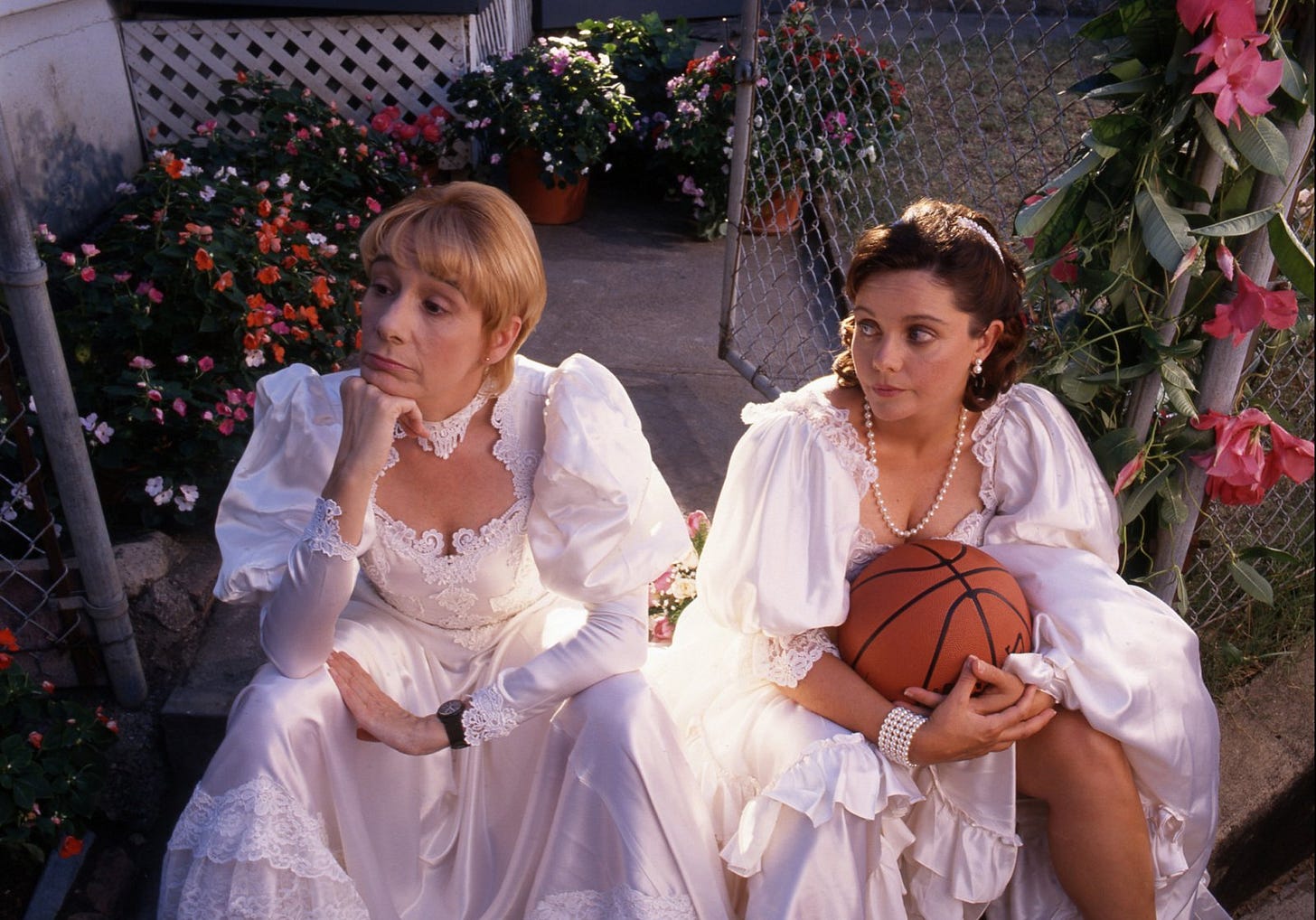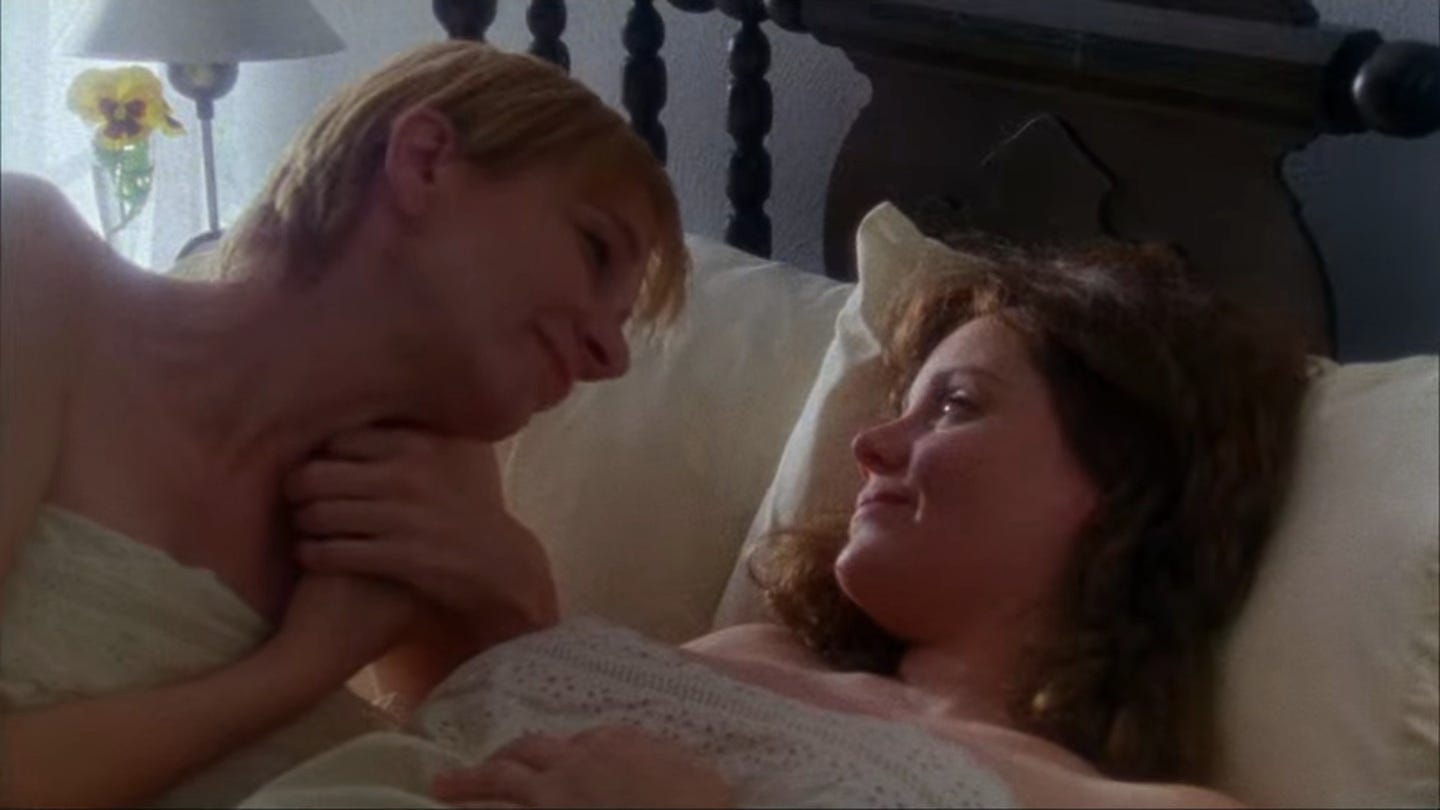Lesbian Film Spotlight: 'Late Bloomers' (1996)
Lesbians don't have to be cool
This is the Sunday Edition of Paging Dr. Lesbian. If you like this type of thing, subscribe, and share it with your friends. Upgrade your subscription for more, including weekly dispatches from the lesbian internet, monthly playlists, and a free sticker.
Several months ago, a 1990s lesbian movie practically no one has heard of made its way to Netflix. Directed by Julia Dyer and written by her sister Gretchen, 1996’s Late Bloomers follows a love story between two middle-aged women working at a high school. The film has no Wikipedia page – though it is included in the Does The Dog Die? database1 – and there’s little record of what discussions about the movie were like at the time. It’s a shame the film is not more well-remembered, as it’s a quirky, unique little movie that’s likely to give you a case of the giggles (and maybe even make you cry).
Late Bloomers takes place in an unnamed Texas town, though it was filmed in Dallas. Dee Hennigan plays Carly, a school secretary, the wife of a math teacher and a mom of 2. Connie Nelson plays Dinah, a fellow math teacher and the high school’s basketball coach. Carly and Dinah become better acquainted when Dinah comes over for dinner one night, and shortly thereafter, Dinah begins teaching Carly how to play basketball. An accidental kiss leads to tension between the two women, and soon they are kissing on purpose.
Their affair is an unexpected delight for them both, and in one of the best scenes in the movie, they play a game of naked basketball (literally – it’s not a euphemism!) one night. Though they initially exist in a lovey-dovey bubble, that bubble quickly pops. Carly tells her husband about the affair, and then her kids, and soon, the entire school knows about their relationship. They face homophobia at work, and in one disquieting moment, the entire basketball team walks off the court when the news spreads through the crowd.
Though there are real obstacles in the way of Carly and Dinah’s happiness, the film never becomes dour or distressing. The second-best scene in the film, following the naked basketball game, takes place at a PTA meeting held on the topic of Carly and Dinah’s relationship. A heated debate erupts between the parents, with some arguing their love is an abomination and others defending the women. In a classic gay clapback scene (The West Wing did it 4 years later), a gay couple quotes Leviticus back to a Christian woman trying to argue that homosexuality is immoral. Meanwhile, Carly, stressed out by the proceedings, makes her way over to the snack table to pick up as many Oreos as she can carry, and then promptly spills them all over the floor.
The film retains its lighthearted tone throughout, including during its cheerful ending, where we get a lesbian wedding a decade before it was legalized in any of the 50 states. This sense of optimism is part of what makes the film so delightful. It’s sweet, funny, and earnest in a way that doesn’t feel forced. It’s also unexpectedly off-kilter, which keeps it from becoming overly sentimental. The lead actors elevate the playful source material, and their easy chemistry and impeccable comedic timing give the film its heart.
Late Bloomers is a fascinating movie because of how it diverges from the norms of queer culture and cinema at the time. It doesn’t fall under the umbrella of New Queer Cinema, a category that includes artsy, intellectual films like My Own Private Idaho and Go Fish. Nor does Late Bloomers align with the norms of lesbian chic,2 the trendy image of lesbians that defined mainstream depictions of queer women during that era. The film’s closest contemporary is probably It’s In The Water, another Texas-based movie about a married woman falling for another woman in her small town. Both films eschew any sense of coolness, aiming for something sweet and goofy instead.
Though these more conventional trappings of aesthetic and story might make the film appear less subversive than other queer films of the era, that’s not the case. The fact that this movie doesn’t care about depicting its queer characters as anything other than everyday people – they’re certainly not chic – is exactly what makes it subversive. As Ann Hornaday wrote in a 1997 New York Times article about the film, Late Bloomers is “radically dowdy.”
Though, as Hornaday writes, the film “celebrates conservative values like family, monogamy and community,” Late Bloomers was a hard sell. It screened at several film festivals, including SXSW and Sundance, but then ran into some issues. While several distributors were interested, their marketing teams weren’t on board. As Gretchen shared with the Dallas Observer, “They said, 'How are we going to sell a movie about lesbians in the Bible Belt in New York and Los Angeles?' And without some kind of hip, urban, in-joke lesbian sensibility, they complained that the film wasn't 'erotic' enough.” The implication here was that the leads weren’t young or sexy enough to be marketable to the general public.
It was eventually picked up by Strand Releasing, an independent studio that champions LGBTQ films. Strand’s release strategy was different than that of other distributors – the film debuted in Texas before heading to the coast in cities like LA, San Fransico, and New York.
This release strategy may have been savvy, but the film wasn’t well-received by everyone, including gay viewers. After a screening in Provincetown, Gretchen recalls a disgruntled lesbian who came up to her and told her the movie was “proof of [her] own internalized homophobia.” A review published in The Advocate, the biggest gay newspaper at the time, expressed similar displeasure. Bob Satuloff wrote that the film is “a comedy with a terminal case of the cutes." Later, he suggested that the film’s earnest disposition may cause "sophisticated gay and lesbian viewers...suffer guilt pangs if they find themselves...rolling their eyes."
These negative reviews didn’t phase the Dyer sisters, who stood by the movie they made. "It was our intention from the start to make a movie not about urban lesbian culture, but two women who'd assimilated into the mainstream," Julia shared with the Observer. Gretchen noted that they “never intended this film to appeal to the New York sophisticate.” Indeed, the notion that women who get up early to put on their unassuming clothes, pack their lunches, and drive their kids to school could also be lesbians is one of the film’s most incisive qualities. As Julia put it, ''The secret subversive message of the whole movie is that if it could happen to these two little ordinary women in middle-class suburbia, it could happen to you,” a statement that certainly sounds threatening to a heteronormative, homophobic culture.
Late Bloomers now exists as both an intriguing piece of film history and a joyful addition to the queer canon. The fact that it doesn’t look like other pieces of contemporary queer media reminds us that there are many ways to capture queerness on film and many ways to embody queerness in life. This hidden gem deserves a second (or first) look.
There are no dead dogs in this movie, in case you were worried.
This link is an article by Eleanor Medhurst of Dressing Dykes – would recommend!
hot mascs wanted
Inquire within about your application. Are there dykes on Sesame Street yet? Which homophobe's death are we celebrating this week?







This is such an exciting recommendation! Can't wait to find where I can watch it
thank you for this rec! i loved the movie